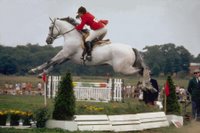
On August 2, USA Equestrian Federation (USEF), Inc., the National Governing Body for "equestrian sports" (such as "jumping," "dressage" and "hunter"), won an antitrust case in the United States Court of Appeals for the 11th Circuit. See Jes Properties, Inc. v. USA Equestrian, Inc., 2006 WL 2136260 (11th Cir. 2006). At issue was the USEF's "Mileage Rule," which
requires that any A-rated recognized competitions held on the same date must be held at least 250 miles away from each other. This is true for all but some Northeastern states, which are subject to a 125-mile radius distance for A-rated competitions. The required distance diminishes as the rating decreases. Unrated or local competitions on the same date can be held within fifty miles of each other. Under the Mileage Rule, an A-rated competition that was held on a certain date in the previous year receives priority.
Florida promoters of for-profit equestrian shows who had lost out on receiving an "A-rating" hoped that the court would declare the Mileage Rule a violation of the antitrust laws. Seems like a pretty clear "territorial allocation," a per se violation of the Sherman Act, right? Not so, says the 11th Circuit. USA Equestrian has "implied immunity" from antitrust laws under the Ted Stevens Olympic and Amateur Sports Act, 36 U.S.C. § 220501 (commonly known as the "Amateur Sports Act," or ASA). That immunity allows a National Governing Body to exercise "monolithic control" over a sport. The court explained:
Therefore, the question for this Court is whether the application of the antitrust laws to the facts of this case would "unduly interfere" with the "operation" of the ASA. . . . Congress has specifically required NGB's to minimize conflicts in the scheduling of competitions and to "develop interest and participation throughout the United States" in their particular sport. The Mileage Rule functions to minimize conflicts and encourages interest in equestrian sports. It forbids competitions of the same rating from being held on the same days within 250 miles of each other. The USEF and the Promoter Defendants adduced evidence that the rule enables the best athletes to compete against each other. If two competitions of the same rating were in close proximity, top athletes may avoid competition against each other and go to different competitions. The USEF and the Promoter Defendants also produced evidence that the rule protects horses from being overworked. If two competitions were very close by on the same dates, horses may be taken from one competition to the next without sufficient rest. Additionally, the rule encourages the spread of equestrian sports throughout the country. If a competition cannot be held in one locality, a promoter may decide to hold a competition in a region in which competition has never been held. Therefore, the Mileage Rule is an exercise of the "monolithic control" Congress conferred on the USEF.One interesting thing going on here is that evidence that a rule is part of the exercise of monolithic control sounds a lot like evidence that an antitrust violation promotes "on field competition." That kind of evidence has been rejected repeatedly by courts adjudicating sports law antitrust decisions. This decision also makes me wonder how how far "monolithic control" might go. Could USA Basketball, for example, decide to implement a rule that affected NBA competitions, on the grounds that it might increase the popularity of the sport of basketball?





0 comments:
Post a Comment